Text
Student Instagram Ambassador for Fall 2021
The Princeton Social Media team is looking to hire the University’s first student Instagram ambassador for the fall semester.
Princeton’s Student Instagram Ambassador will produce at least one piece of content for Princeton’s Instagram account each week of the semester. Content may include a feed post, Reel, IGTV or Instagram Story
Content will provide an inside look of campus life and student experiences ranging from campus beauty, events, academics, athletics, campus activities, etc.
Princeton’s Student Instagram Ambassador will be a public facing role, where our audiences will learn their point of view and experiences on campus and in the classroom
Who we are looking for:
An undergraduate student who is interested in sharing their Princeton experience with the world, but especially with prospective and current students
Someone who lives and breathes Instagram and all of the many features the platform offers
In addition to an interest in Instagram, the student must also be organized, responsive to emails and meet weekly deadlines for content. The student will also be required to meet with the social media team at least 1-2 times a week.
How to apply:
Send an Instagram Reel by September 20, 2021 to [email protected], explaining why you should get the gig
This position is open for the fall semester with the possibility of an extension into Wintersession and the spring semester
All content will be approved through the Princeton Social Media Team
This is a paid position
3 notes
·
View notes
Text
Princeton’s Top Social Media Moments of 2019
2019 was a year of celebrating and recognizing Princetonians who are changing the world and living out our informal motto of “In the nation’s service and the service of humanity.”
Here are the stories and moments that surfaced to the top of our social media feeds.
Princeton’s James Peebles receives the 2019 Nobel Prize in Physics
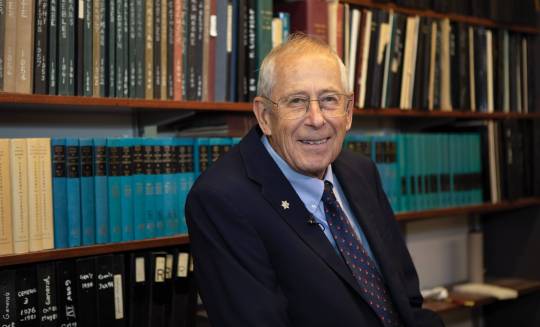
On October 8, 2019, the world woke up to the news that professor emeritus James “Jim” Peebles *62 had received the 2019 Nobel Prize in Physics “for theoretical discoveries in physical cosmology.” Our team immediately took to social media to mark the occasion and give minute-by-minute updates as the University community celebrated Professor Peebles. Some of our social media coverage even made its way to a local news broadcast. When Professor Peebles traveled to Sweden in December to receive his Nobel, we were able to look back and re-share some of the great moments from October.
#1 most liked post on Facebook post
#1 post with the most reach on LinkedIn
#1 most viewed video on YouTube
#1 most liked post on LinkedIn
#2 most watched Facebook Live
#2 most commented post on Facebook
#2 most liked post on Facebook
#2 most commented post on LinkedIn
#3 most shared post on LinkedIn
#3 post with the most reach on Facebook
Princeton remembers Toni Morrison, Nobel-winning author and emeritus Princeton faculty member
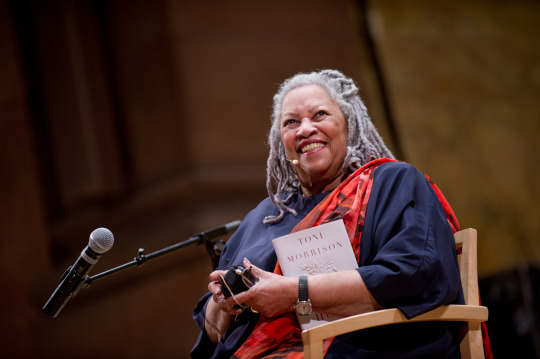
In 2019, we lost many notable Princeton faculty members including professor emerita Toni Morrison. After announcing that she had passed away, the University used social media to celebrate her legacy, her impact and beautiful words ... and the world listened and shared in the moment. (Photo credit: Sameer A. Khan/Fotobuddy)
#1 most watched video on Facebook
#1 most shared post on Facebook
#1 most shared post on LinkedIn
#1 most watched video on LinkedIn
#2 most liked post on Facebook
#2 most watched video on Twitter
#3 most commented post on Facebook
#3 most shared post on Facebook
#3 post with the most reach on Facebook
#3 most commented post on LinkedIn
#3 post with the most reach on LinkedIn
#3 most liked post on LinkedIn
Michelle Obama ‘85 gives video welcome message at Alumni’s “Thrive” Conference
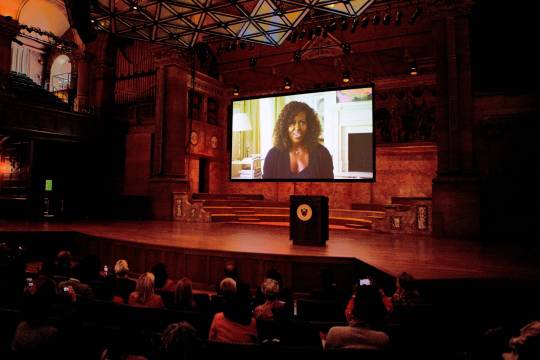
Michelle Obama ‘85 surprised more than 1,200 Princeton alumni and guests at “Thrive: Empowering and Celebrating Princeton’s Black Alumni” with a video message. Immediately following the moment, we posted the video on social media for the rest of the world to watch.
#2 most watched video on Facebook
#2 most shared post on LinkedIn
#2 most watched video on LinkedIn
#2 most shared post on Instagram
#3 most watched video on Twitter
Graduate student Xiyue Wang returns home after unjust imprisonment in Iran

In the summer of 2016, Princeton graduate student Xiyue Wang was detained by Iranian authorities while studying the Farsi language and doing dissertation research. Wang was charged with espionage, convicted and sentenced to 10 years in prison. Ever since, the University community has been rallying in support of his release. On December 7, 2019, Xiyue Wang was released thanks to the United States government, the government of Switzerland, and the students, faculty and staff who continued to advocate for his freedom throughout this ordeal. (Photo credit: U.S. Embassy Switzerland)
#2 post with the most reach on Facebook
#2 most retweeted post
#2 most liked post on Twitter
#2 most liked post on LinkedIn
#4 post with the most reach on Twitter
#4 post with the most reach on LinkedIn
Looking ahead to 2020
Video continues to remain a dominate form of content for sharing our stories and messaging across platforms. However, we will continue to create content for specific channels and audiences - one piece of content does not fit all. Also, Twitter is not dead as we incorrectly predicted in 2017. Twitter has become an instrumental vehicle in adding Princeton’s voice to international conversations especially around climate change, innovation, and college access and affordability. Finally, LinkedIn is making a come back. This year, the top viewed video on LinkedIn was watched more than the top viewed videos on Twitter and Facebook. LinkedIn continues to be a platform of untapped potential especially as it continues to unveil new features.
Regardless of platform or features, authentic and timely content remains constant which we hope to continue to bring to our social media audiences in 2020.
- Jessica Leontarakis, social media strategist and Maddy Pryor, social media specialist
#Social media#hesm#Princeton University#PrincetonSM#PrincetonU#year in review#Toni Morrison#Nobel Prize#Michelle Obama#video marketing#LinkedIn#Twitter
5 notes
·
View notes
Text
Princeton’s Top Social Media Moments of 2018
While 2017 was fueled with space, politics and puppies, messages of empowerment and perseverance resonated most with our social audiences in 2018. Whether it be a FLI student (first-gen, low income student) sharing their journey to Princeton or a campus visitor delivering words of hope and change, our social audiences craved inspiration.
First-gen stories inspire our audiences to engage and share
Princeton is committed to finding the best and brightest minds from around the world regardless of their background or family income. Throughout 2018, our social media channels put a voice and conversation around these stories - in particular our #TellUsTigers series provided a platform for students to shed light on their journeys using 2,200 characters.
Facebook #1 most watched video: Ana Patricia ‘19
Facebook #2 most liked post: #TellUsTigers Lucy Chuang ‘21
Facebook #2 most reached post: #TellUsTigers Daniel Jose Navarrete ‘19
#Instagram #2 most commented post: #TellUsTigers Lucy Chuang ‘21 (below)
#Instagram #3 most commented post: #TellUsTigers Daniel Jose Navarrete ‘19
#Instagram #3 most reach: #TellUsTigers Lucy Chuang ‘21(below)
View this post on Instagram
A post shared by Princeton University (@princeton) on Nov 15, 2018 at 2:31pm PST
There’s nothing more exciting (or shareable) than when you find out you’ve been accepted to #PrincetonU
The Class of 2022 and the Class of 2023 sure know how to make a grand entrance on social.
Facebook #1 most commented post: 2023 early action announcement
Facebook #1 most reached post: 2022 regular decision announcement
Facebook #2 most clicked post: 2022 regular decision announcement
Facebook #3 most liked post: 2023 early action announcement
Instagram #1 most liked post: 2023 early action announcement (below)
Instagram #1 most commented post: 2023 early action announcement (below)
View this post on Instagram
A post shared by Princeton University (@princeton) on Dec 12, 2018 at 4:02pm PST
She Roars (and she’s social)
This year, Princeton hosted the She Roars alumni conference, the largest event in the University’s history held during the academic year which also made a splash on social media. The spirit of the conference lives on in an all new ”She Roars” podcast where change-making women discuss their career pathways and experiences at Princeton University.
Facebook #2 most shared post: SCOTUS discussion
Twitter #2 most watched video: Asha Rangappa ‘96 podcast (below)
Twitter #3 most watched video: Frances Arnold ‘79 podcast
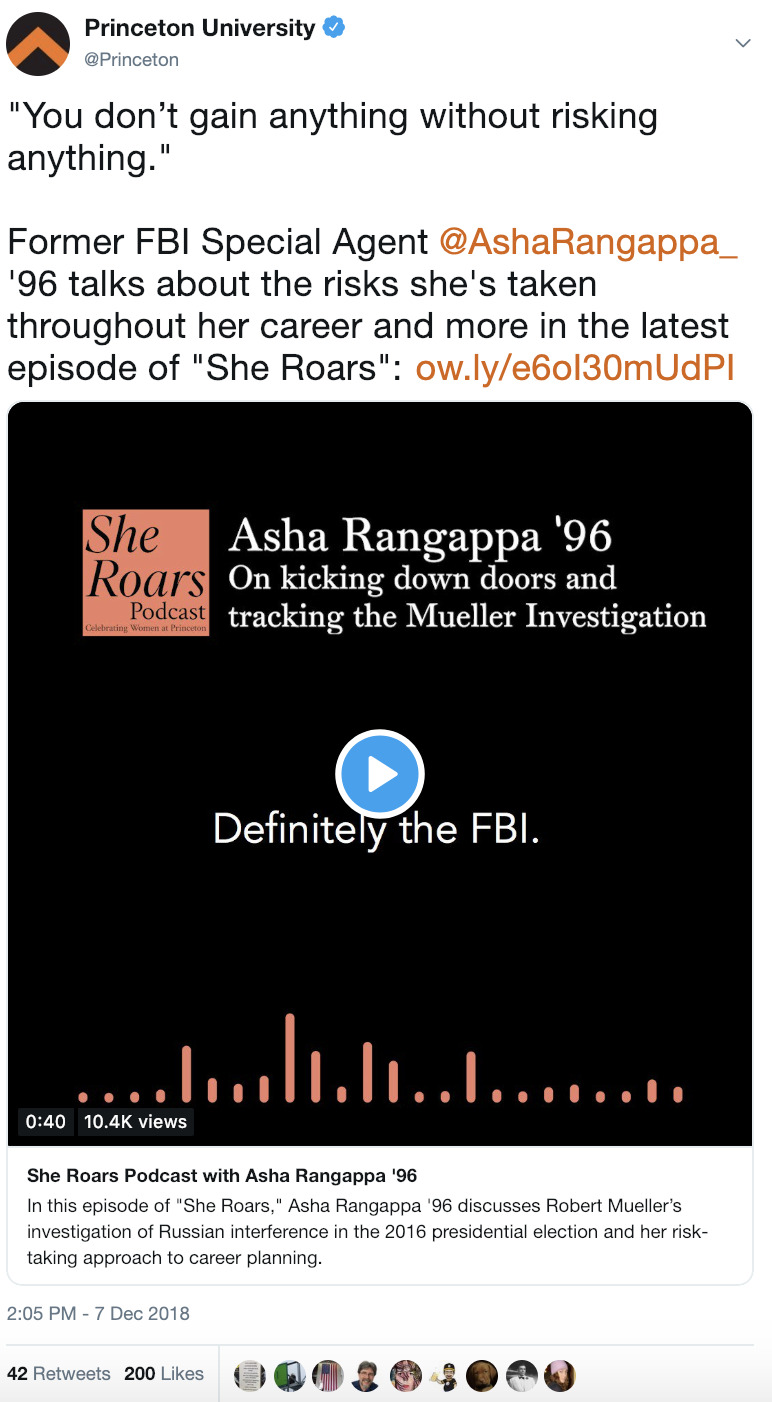
Messages from speakers extend beyond their visit to campus
From Senator Cory Booker to Ellie Kemper to Nobel laureate Frances Arnold, Princeton University hosted a range of guests throughout the year. Their words became some of the most engaged with content on our channels.
Twitter #2 most liked: 2018 Class Day speaker Cory Booker (below)
Twitter #2 most watched video: Asha Rangappa ‘96 podcast
Twitter #3 most retweeted: 2018 Class Day Speaker Cory Booker (below)
Twitter #3 most watched video: Frances Arnold ‘79 podcast
Facebook #2 most shared post: SCOTUS discussion

7 notes
·
View notes
Text
Princeton wellness program wins innovation award with the help of Snapchat
The National Association of College & University Food Services presented Princeton University Campus Dining with the top award for “2018 Most Innovation Nutrition and Wellness Program.” The annual award recognizes colleges and universities that have implemented a unique and effective wellness or nutrition program during the previous year.
In an effort to directly educate students on how (easy it is) to make nutritious meals, Campus Dining partnered with the Office of Communications to film a series of culinary demos on Snapchat. These stories complimented events happening across campus. Watch the stories below!
vimeo
vimeo
Each Snapchat story received nearly 2,000 views and the recipes were screengrabbed up to 50 times. They were also met with high praise and interest from followers.

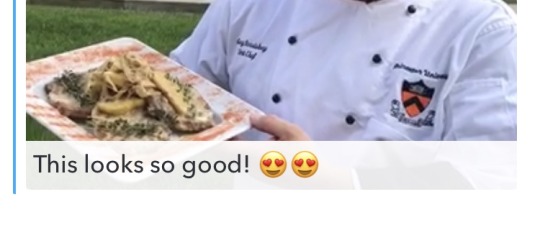

“It was a very proud moment for us in the areas of health, wellness and innovation,” said Melissa Mirota, campus wellness dietitian at Princeton University.
Read more and download the recipes.
0 notes
Text
She Roars...She Tweets...She ‘Grams
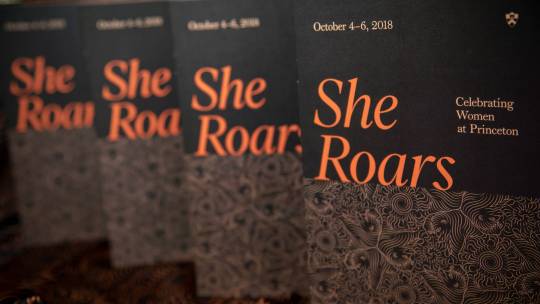
She Roars...She Tweets...She ‘Grams and we were there to capture it all! For three days, Princeton University hosted a conference for alumni* entitled “She Roars: Celebrating Women at Princeton.” More than 3,300 Tigers descended onto campus to listen to panels, participate in discussions and meet up with old classmates, and social media was at the center of it all. Here’s how a team of two covered the largest event in the University’s history held during the academic year:
*Even though the conference celebrates alumnae, attendees included women and men
Start with a plan but be flexible
Social media was involved from the early stages of planning the conference. This helped us understand the expectation and role of social media. From there, we developed our own planning document of goals, roles, tactics and content. This was our guiding light from planning to execution and was referenced hundreds of times (we highly recommend using Google Documents or a cloud-based word processing platform). As the conference evolved, it kept us organized and focused on what we wanted to achieve on social media.
As much as we planned and re-planned, when it came down to execution, we learned early on we needed to be flexible. For instance, we were asked to attend a panel that wasn’t part of our coverage plan. We just made it work. We had also planned to snap alumni video messages for Snapchat, but we didn’t have the bandwidth to complete the task.
Divide and Conquer
With a conference spanning across the University and over the course of three days, the reality was that we were not going to be able to cover everything. With our plan, we worked very closely with our colleagues in the Office of Communications as well as Alumni Affairs to coordinate coverage. This was the most critical step in all of our efforts because we forged a content army that conquered all of the great moments and stories from more than 3,300 attendees. Communication was key in making this a success, we were Slacking, emailing and DMing up until the very end.
In terms of the University’s social media team, Maddy was “the reporter on the ground” while Jessica was back at the office posting homepage stories and performing community management (responding, retweeting and liking posts). We also met with the social media team in Alumni Affairs and shared our coverage plan. The outcome of the meeting was one shared document, so we didn’t duplicate efforts throughout the conference. It took time to pull the information together, but it was an invaluable asset for all teams. We also got the word out about the conference to campus partners through our weekly social media newsletter. Don’t assume that others know the hashtag - tell them - and then remind them again!
Have a strategy for each platform
Just like the University’s social media strategy, we treated each platform separately and delivered content based on the audience and their expectations. We were very careful to craft and format content based on the features of each platform. Here’s how we broke it down:
Twitter: Live coverage and daily wrap-ups through Twitter Moments
Facebook: Headline stories and livestreaming
LinkedIn (yes, LinkedIn!): Headline stories and alumni stories who have LinkedIn accounts
Instagram: Photos of the most memorable moments
Instagram Stories: Live coverage and sharing user generated content
Here’s an example of how we shared the story about the opening reception on Facebook and Twitter.

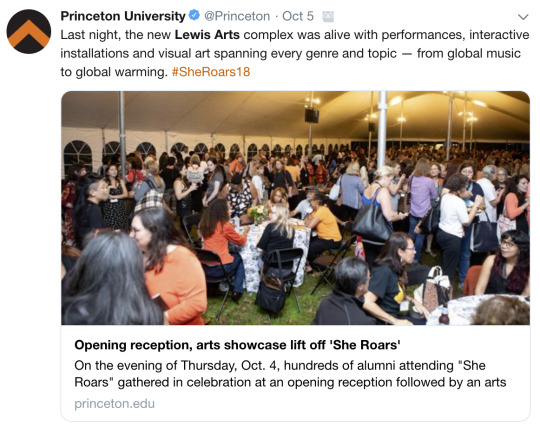
Look Good
Branding! We wanted to look as official online as the conference did offline. Working with our graphic design team, we created an avatar, cover photo and quote card for each of our channels. We also included conference information in each of our profile bios so our followers understood why we looked different.

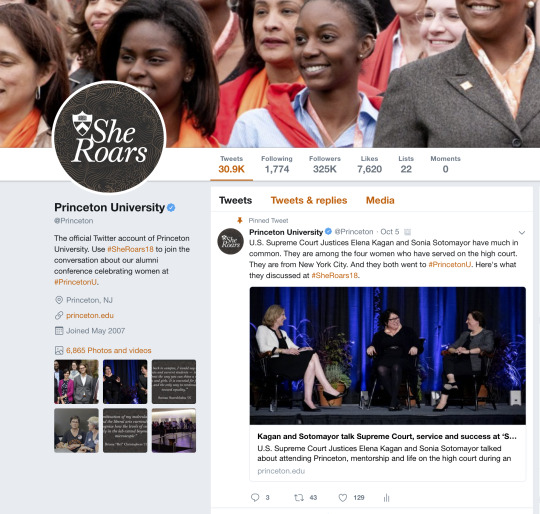
Live Smart Coverage
With more than 90 events and more than 200 presenters, we needed to be highly selective in what we covered live. So how did we choose? We went through the very manual process of researching presenters and their followings on Instagram and Twitter, but the time invested in the process proved valuable when we saw the social media reach of the panels we decided to cover. For the events we weren’t able to attend, we re-shared content from other accounts.
Here are the tactics we deployed while covering events live:
Photos: With the use of a WiFi SD card, we used a DSLR camera so that our photos were high res, up-close-and-personal. Our goal was to have our photography be as powerful as the text accompanying it.
Quotes: We listened for key messaging about the University and our alumnae, and let the jokes, audience questions and political/cultural content come from attendees.
Tagging: We tagged presenters and their companies wherever we could in hopes their accounts would share our content.
Facebook Live: For the events that were livestreamed, we asked our Broadcast Center to post the stream through our Facebook page. We have found much more engagement when events are streamed through our page verses posting a link.
An example of how great photography paired with a great quote can lead to great engagement.
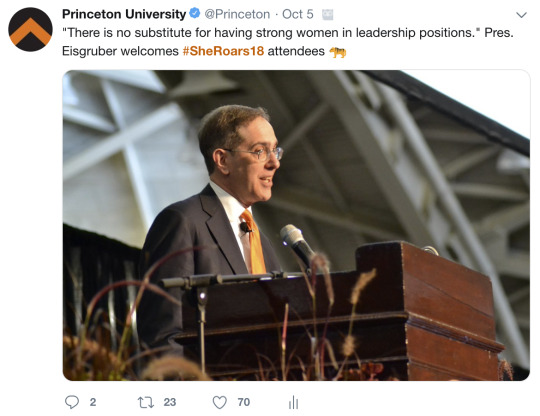
Takeaways
Get a seat at the table from the beginning.
Always have a plan, but know how to pivot.
Don’t miss the opportunity to visually brand your accounts. It aligns with the overall conference and creates context for your followers.
One size doesn’t fit all. Take the time to deliver content based on your audience and the features of each platform.
If you’re a small team or even a team of one, leverage campus partners. Engage them early on the planning so everyone is on the same page.
Don’t cover everything. Find the events with the biggest impact based on social reach and re-share content from others.
High quality photos and copy lead to engagement
Outcomes and Looking Ahead
From October 4-7, 231 posts generated nearly 1.4M impressions from the University’s channels - several posts exceeded the performance of our monthly benchmark. Numbers aside, we received feedback from alumnae who couldn’t join in person saying how appreciative they were that they could follow the conference in real-time. Our social media presence also helped facilitate media requests and answer logistical questions from attendees.
Looking ahead, we hope to use this conference as a case study for events to come with some tweaks. For instance, we wish we could have done an exclusive Facebook Live interview with a panelist. We also wish we had a social media listening tool to better understand the reach of the conference beyond the engagement of our own channels.
Special Thanks
None of this would have been possible without the support and help of Alumni Affairs as well our own colleagues in the Office of Communications. It was a collective effort!
– Jessica Leontarakis, social media strategist
– Maddy Pryor, social media specialist
3 notes
·
View notes
Text
Princeton University’s Top Social Media Moments of 2017
What was our most liked post on Facebook? Which post was retweeted the most? As 2017 winds down, we are taking a look at some of our top moments on Facebook, Twitter and Instagram.
Solar eclipse in 90 seconds
It was a week before 2017’s total solar eclipse and our team brainstormed up the idea to create a short informational video using a Princeton astrophysicist as the expert. This was a new concept and process for our team. Many of our videos are between 4-5 minutes and take several weeks of planning and filming. The results:
Facebook: #1 most watched video
Facebook: #3 most shared post
Twitter: #1 most watched video
All you need to know about the #SolarEclipse in 90 seconds with #PrincetonU astrophysicist Amitava Bhattacharjee. pic.twitter.com/lV74cAwVrZ
— Princeton University (@Princeton)
August 18, 2017
Response to federal immigration executive order
On Sunday, January 29, 2017, President Eisgruber issued a statement in response to the federal executive order barring entry to the United States for refugees and for citizens of seven predominantly Muslim countries. Days later, President Eisgruber and 47 other American college and university presidents sent a letter to President Trump urging him to “rectify or rescind” the executive order. Both stories were posted to the University’s website and then immediately distributed to our social media channels. Here’s how our social audiences reacted:
President Eisgruber issues statement on federal immigration executive order
Facebook: #2 most liked post
Facebook: #1 most commented post
Facebook: #1 most shared post
Facebook: #1 most clicked post
Twitter: #1 most retweeted post
Twitter: #1 most liked post
Princeton President Christopher Eisgruber has just issued a statement on the federal immigration executive order. https://t.co/KbtdBIpTd7
— Princeton University (@Princeton)
January 29, 2017
Eisgruber, other university presidents ask President Trump to ‘rectify or rescind’ immigration order
Facebook: #2 most shared
Twitter: #2 most retweeted post
Twitter: #2 most reach
Eisgruber joins college presidents urging @realdonaldtrump to rectify damage done by executive order on immigration: https://t.co/05Jdwp4xAP pic.twitter.com/0aFEW7fRw0
— Princeton University (@Princeton)
February 2, 2017
#TellUsTigers About Your First Day of College
Launched in February 2016, Princeton’s weekly #TellUsTigers campaign introduces the world to Princetonians, one post at a time. It initially began as an Instagram campaign, but is now shared on Facebook and Twitter. On the first day of classes, we shared the story of Camden Olson ‘19 and her service dog, Koa. Not only did the post break our record of most liked Instagram post, but it also was the most liked post on Facebook. Some may say we cheated by placing a cute puppy in front of iconic Nassau Hall, but read the comments and you’ll find people took the time to read all 2,200 characters. Readers were truly touched by the service dog team’s mission to help Type 1 diabetics.
Facebook: #1 most liked
Instagram: #1 most liked post
Instagram: #2 most commented post
#TellUsTigers about your #firstdayofcollege: "Meet Koa (@koatheservicepup), a #comfortretriever. The seemingly effortless trust and communication that accompanies a working service dog team is truly beautiful. Next year, as part of my senior thesis research, I'll have a chance to observe this relationship by training Koa to be a #diabeticalertdog on campus. I will teach him how to alert to high and low blood glucose levels before placing him with a Type 1 diabetic. I will also teach an after-school program that teaches middle school students how to train service dogs; the kids will work with Koa. If you see Koa on campus with his service vest, please do not pet or distract. When I was little, I was terrified of dogs. That all changed when my grandma brought home Inukshuk, an 8-week-old #blacklab. Inukshuk is a cairn, or a trail marker, who has guided me on my path to discovering my passion for training service dogs. Working with a dog teaches me new lessons every day. I took a gap year before starting at #PrincetonU to raise a guide-dog-in-training, Derby. One of the most important things he taught me was to live in the moment. He mirrored my mood and if I was stressed about something, his less than adequate behavior was a constant reminder to focus on the work immediately in front of me. (This is a skill that has come in handy at Princeton.) When I dropped off Derby for the test that would determine whether he would continue his #guidedog training, I cried but a huge smile accompanied my tears. I was so proud of him. We had worked so hard for this moment. As part of my work with Derby and his trainer, we entered a busy mall. His trainer turned to me, handed me a blindfold and the leash. A cloud of darkness surrounded me as the fabric pressed against my face. I could hear the trickle of an indoor fountain and children playing down the hall. I felt the gentle tug of leather in my grasp, as I grabbed onto the harness handle. Disoriented, I turned to my dog, trusting Derby, just as he had turned to me so many times before. — Camden Olson, Class of 2019 #Princetagram #diabeticalertdogintraining #t1dwarrior #servicedogsofinstagram #servicedogintraining #collegedog
A post shared by Princeton University (@princeton_university) on Sep 13, 2017 at 6:03am PDT
Key Takeaways
Be timely. As seen in all three moments, we learned that content must be topical and relevant to our audiences. Our editorial calendar is focused on sharing stories about how students, faculty and staff are making a difference in the world through research, publications and service as well as highlight important events on campus. As we shifted in telling more timely stories, we saw an exponential increase in engagement and reach for stories that were aligned with the news cycle. With more flexibility and quick thinking, we hope to do more of this in 2018.
Create short videos with high impact. At first, creating a compelling 90 second video seemed impossible as our team is accustomed to creating 4-5 minute videos. With careful planning, targeted questions and creative editing, we achieved our goal and were inspired to create more short videos that went on to be top performing content as well. For instance, we took this video of our vertical farm project and worked it into a short video which became the second most viewed video on Facebook.
In 2018, we hope to continue delivering short videos for our social audiences, some may be created from scratch while others can be created using existing footage from feature videos from the website.
Instagram > Twitter. This year, we were especially surprised to see that even though we have a larger following on Twitter, we received more engagement and better quality engagement on Instagram. For instance, the most watched videos on Twitter received between 4,000-6,000 views whereas on Instagram, the most watched videos received between 9,000-12,000 views. We saw this with click-throughs as well. A link in our Instagram Stories consistently outperformed a link included in a tweet.
More Facebook Lives = More reach. In addition to looking at likes, comments and shares, we analyzed which posts received the most reach on Facebook. Our Facebook Live broadcasts reached the most people, making 2017 the year of the Facebook Live broadcast for Princeton Social Media. We broadcasted our annual P-rade, Opening Exercises, Commencement as well as produced exclusive content including a rock concert, a pumpkin toss and an hour-long telethon. The more we did, the more we learned and expanded our equipment and caliber of broadcast. As we wrapped up the year, it was great to see our efforts rewarded by seeing that this content received the most reach. Will 2018 continue the year of Facebook Live? We are planning for it and will also stay apprised of new features coming out of Facebook.
So there you have it. #PrincetonSM in 2017. Happy New Year to all!
-Jessica Leontarakis, social media specialist
#Princeton University#PrincetonU#princetonuniversity#princetonsm#socialmedia#hesm#highered#top stories
0 notes
Text
Dan Day on The Impact of Technology in Higher Education Communications
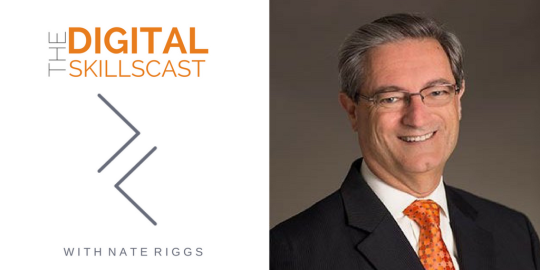
Dan Day, assistant vice president for communications at Princeton University recently sat down with Nate Riggs from the podcast, Digital Skillscast to discuss how technology impacts higher education communications.
View the full post here.
</p>
1 note
·
View note
Text
Meet Princeton’s New Weibo Intern: Jianing Zhao ‘20
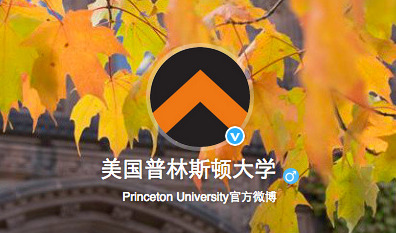
In early 2015, Princeton Social Media committed efforts to our first Chinese-language social media platform, Weibo. Throughout the year, Jianing Zhao will help us share the full story of an academic year at the University with our Weibo followers. In addition to posting content similar to what we share with our English-language audiences in Mandarin, Jianing will share her own original updates, photos and blog entries targeted specifically to our Weibo audience. Without further ado, meet the new voice behind our Weibo account, Jianing.
This is Jianing, the social media intern for Princeton’s social media team! I manage Princeton’s official Weibo account (one of the most popular social media sites in China) and sometimes contribute posts to the University’s Twitter, Instagram and Snapchat accounts. At Princeton, I’m a sophomore concentrating in comparative literature and pursuing certificates in archeology, theater, and gender and sexuality studies. Outside of academics, I’m the head editor of “the Street” (Art & Culture) section of the Daily Princetonian, the president of the Russian Undergraduate Student Association, and I am currently directing a play for Princeton Chinese Theater.
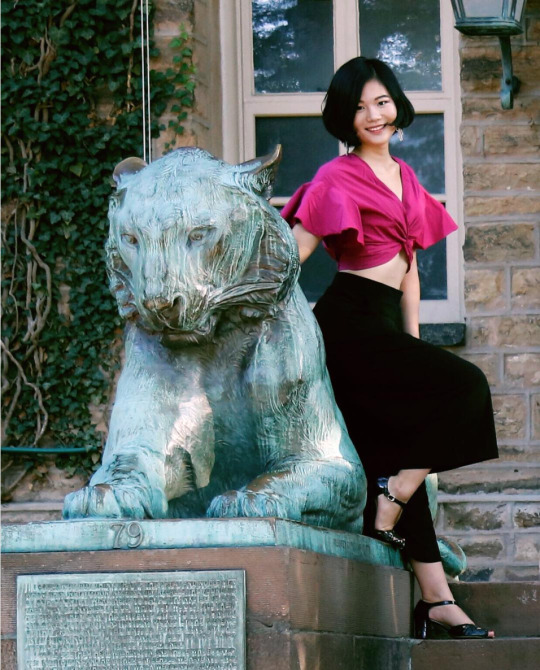
As one who plans to go into communications and media for a future career, I’ve really enjoyed interning for Princeton’s social media team, as it not only has taught me how to frame content for different target audiences across different social media platforms, but also allowed me to get out of my comfort zone and interact with students across campus, which seems intimidating but turns out to be fun and rewarding!
- Jianing Zhao, Social Media Intern
1 note
·
View note
Text
How We Used a Meta Tag Strategy and Drupal to Look Our Best on Social Media

The new princeton.edu uses big, beautiful images to tell Princeton’s story, a substantial change from the old site. In a new article on RE(design), the Princeton University Website Redesign Project blog, digital manager Christian Knoebel gives a behind-the-scenes explanation of the programming that helps translate those images to social media posts. The strategy helps us maintain our goal to be visual on social media as often as possible.
Read the article here.
#Social Media#meta tags#Drupal#PrincetonSM#PrincetonU#Princeton University#Website#programming#photography
1 note
·
View note
Text
Social Media at the 2017 Fung Forum
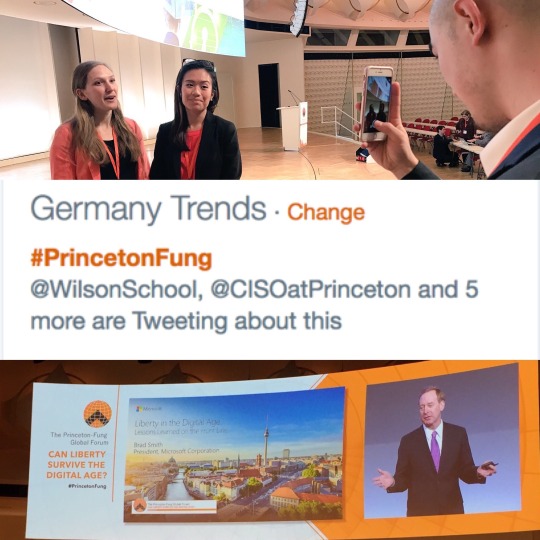
What's it like to lead social media coverage for an international conference? This was my experience at the 2017 Fung Forum.
Princeton Social Media provided live social media coverage of the Princeton-Fung Global Forum, March 20-21, 2017, in Berlin, Germany, in order to share and enhance conversations held at the conference. Through the implementation of original social media updates, photos and videos as well as user-generated content, it is possible that hundreds of thousands of people now associate Princeton with the discussion surrounding one of today’s most pressing questions: Can liberty survive the digital age?
I accompanied Woodrow Wilson School staff to the conference to create and curate content for the University’s primary social media accounts on the following platforms: Facebook, Twitter, Instagram, Snapchat and Storify.
Coverage included live tweeting throughout each day of the conference, three Facebook posts including a Facebook Live broadcast, two Instagram posts, two Snapchat stories, a Storify collection of attendees’ social media posts and two daily Princeton homepage articles.
The University’s social media coverage was supplemented by a team of students who provided conference updates from their perspectives by sharing photos in a WhatsApp group and on personal Twitter and Instagram profiles, which I shared on the main Princeton accounts. Students also created content for Princeton’s Snapchat account for the duration of the conference. The inclusion of student voices in Princeton’s social media output contributes to a sense of authenticity for a large portion of the University’s audience.
vimeo
2017’s social media metrics show an improvement over metrics from the last Fung Forum, which occurred in 2015, in several significant measurements including the reach of our content, the number of times the #PrincetonFung hashtag was used, and video views. Overall, more people talked about the Fung Forum and saw more conference-related content in 2017 than in 2015.
#PrincetonFung became a trending topic on Twitter’s Trends list both days of the conference. Per Twitter, “the Trends list is designed to help people discover the ‘most breaking’ breaking news from across the world, in real-time. The trends list captures the hottest emerging topics…”
The Trends list amplified the Fung Forum hashtag and related content, meaning more people were made aware of it and therefore saw content combining Princeton University and conversations about liberty in the digital age that they otherwise would not have.
More social media conversation mirrored, and hopefully contributed to, increased conference attendance from the beginning of day one to the well-attended final sessions through Princeton University President Eisgruber’s closing remarks on day two when compared to the 2015 Fung Forum.
In addition to hosting speakers, panelists and attendees from around the world, the inclusion of social media promotion, live coverage and content curation in the conference’s communication strategy helped make the 2017 Fung Forum a truly global event.
-Ryan Maguire, Social Media Strategist
#Princeton#PrincetonSM#PrincetonU#Social Media#Fung Forum#PrincetonFung#Germany#Berlin#Facebook#Twitter#Instagram#Snapchat#Storify#hesm#Higher education#cybersecurity
1 note
·
View note
Text
A Summer Snapchat Mini-Series
While many Tigers spend summer studying abroad or interning, some stay on campus to participate in the Keller Center’s Tiger Challenge. Using design thinking, students work on developing innovative solutions to some of society’s most pressing problems. This year’s cohort is working to address the following questions:
How might we design a better way to measure pulse and blood-oxygen levels in infants?
How might we help eliminate new cases of lead poisoning in Trenton, NJ?
How might we help Princeton town officials design a more participative and effective climate action planning process?
How might we help more refugees in NYC begin stable and fulfilling careers?
Throughout the 10-week program we are capturing student snaps in a Snapchat mini-series, “Tales of the Tiger Challenge,” and will air the story every Friday at 3 p.m. EST. Each week, viewers will get a glimpse as to how the students are grappling with their topics and making progress toward developing innovative solutions.
Be sure to follow princetonu on Snapchat and tune in Friday at 3pm EST to watch “Tales of the Tiger Challenge.”
youtube
- Jessica Leontarakis (@jessicafill), Social Media Specialist
2 notes
·
View notes
Link
Princeton Social Media Day is a free, all-day, professional development event to engage, educate and empower students, faculty, staff and alumni to use social media more effectively. Under the leadership of Director of Career Services Eva Kubu, Princeton Social Media day has become an event many in the University community look forward to each year.
Hashtag Higher Ed, a podcast on higher education marketing, recently interviewed Eva about lessons from Princeton Social Media Day. Read more and listen here.
#Princeton#Princeton University#PrincetonU#PrincetonSM#Princeton Social Media Day#PUSocialDay#eCity Interactive#Podcast#HESM#Career Services#Careers
1 note
·
View note
Video
vimeo
Princeton University says “thank you” to its Instagram community, which grew to include 100,000 followers between 2012 and 2017.
1 note
·
View note
Text
Social Media Sizing Cheat Sheet
In order to have high-impact, high-quality content on social media, it’s important to abide by each network’s image guidelines. A photo used on Instagram may not be as shareworthy on Twitter if it isn’t sized correctly.
At Princeton, we work with our creative and multimedia teams to develop assets that fit with the guidelines of each platform. Although it requires a little bit more time to customize individual assets, in the long run, our messaging comes across as clear and prevents us from running up against an “unable to upload” notification.
Here is a simple “cheat sheet” for the channels Princeton is active on that our team references for creative guidelines. It’s important to note that as devices and platforms evolve, so do guidelines, so be sure to update this document accordingly.
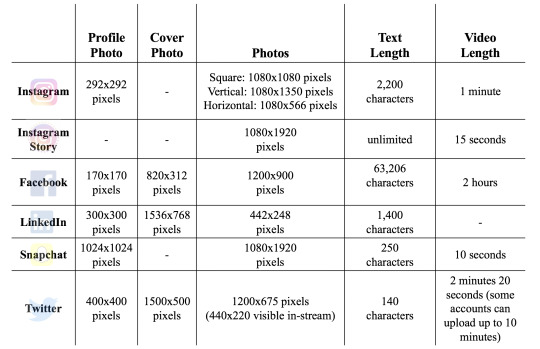
Additional information and resources:
“When I share a photo on Instagram, what's the image resolution?” - Instagram
“What are the dimensions of my Page's profile picture and cover photo?” - Facebook
“Video Views” - Facebook
“Image Specifications for Your Company Pages and Career Pages” - LinkedIn
“Advertiser creative specifications” - Twitter
“Customizing your profile” - Twitter
“Media Studio Support Page & FAQ” - Twitter
“Geofilter tips” - Snapchat
- Jessica Leontarakis (@jessicafill), Social Media Specialist
11 notes
·
View notes
Text
Working Together for #OurTomorrow
Gwen McNamara is the Communications Coordinator in the Pace Center for Civic Engagement
youtube
Following the election in November, we here at the Pace Center for Civic Engagement asked ourselves an important question: Now what? What do we do to help students take positive action and make an impact? And we knew we probably weren’t the only ones asking that question.
So we did something different. We reached out to many of our peer service and civic engagement centers across the U.S. and said, “Hey, want to think about this together?” The answer was an overwhelming “Yes!”
As we connected over conference calls and email, we realized that we all had amazing students, faculty, staff and others doing really great things on our campuses and in the community. Great things that deserved a bright spotlight and could be even more powerful if we could somehow bring them together to show that engagement matters not just in one city or town, but all across the country.
Enter social media and #OurTomorrow. Starting on January 16, Martin Luther King Jr. Day, we launched the #OurTomorrow campaign using a Tumblr blog as our home base with Juicer, a social media aggregator, to pull tweets, posts and pictures together. So what have we learned so far?
Make it easy for people to join in.
We realized that with our diverse audience of possible participants – university centers, academic departments, students, faculty, staff and community members – we couldn’t limit ourselves to using just one social media platform. We also needed to give our campaign partners some simple tools to get buy-in from university higher-ups and attract students and other participants.
Using Google Drive, we created a short one-page campaign description with sample social media ideas to convey what #OurTomorrow is about and how you might contribute. We also shared fill-in-the-blank recruitment emails and simple #OurTomorrow graphics that folks could use on photos or other materials if they needed images to go with their posts.

Make it your own.
Each university is unique with our own styles and campus cultures, so we left it up to each institution to develop its own strategy and plan for rolling out #OurTomorrow.
“It has been exciting to see how many institutions and centers have been able to implement the campaign in different ways,” said Nicole Caridad Ralston, Program Manager at the Center for Public Service at Tulane University. “We used it for our MLK Jr. Day of Service, which is a combined effort with Loyola University New Orleans, Xavier University, The University of New Orleans and Tulane University.”
At Stanford University, #OurTomorrow became the overall theme and title for the Haas Center for Public Service’s “week of action” which brings people together from across the university to collaborate on programming for students and staff. “It helped with promoting the events to have a common theme and joint marketing effort,” said Virginia Bock, Communications Manager at the Haas center for Public Service.
At Princeton, we teamed up with the Pace Council for Civic Values, a team of student service ambassadors at the Pace Center, to take photos of students as part of a “Now what?” poster campaign. Students shared what they stand for, who they stand with, or what they stand against and we shared their stories on Instagram.
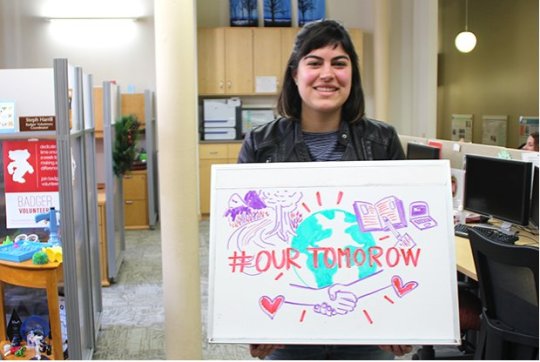
Sharing knowledge and resources rocks.
Coming together around one communications project has enabled everyone participating in the #OurTomorrow campaign to not just connect with one another, but learn from one another too.
“It’s been great to get exposure to other ways of doing things, specifically how other organizations are handling similar situations on their campuses,” said Laura Anca Chichisan, Communications Coordinator with the Priscilla King Gray Public Service Center at the Massachusetts Institute of Technology. “I’ve also appreciated the sense of solidarity between us.”
“#OurTomorrow has helped me understand how many activities our college students are engaged in to try to make their communities better,” added Peter Cerneka, Associate Director for Student Engagement at Columbia College, part of Columbia University. “It’s easy to get lost in the business of the day-to-day and lose sight of the sincere but often unheralded efforts by people to do their parts. #OurTomorrow has shined a light on many of those efforts.”
We want to keep it going!
#OurTomorrow is just beginning. As the spring semester progresses, how can ongoing student activism, alternative break trips, weekly volunteer projects, or new workshops or events all help keep momentum going? How can sharing our story through this blog or with articles like the one from the
Morgridge Center for Public Service at the University of Wisconsin, Madison
keep spreading the word and grow our efforts?
Inspired to join in? Simply use #OurTomorrow to share how you, your organization or your institution is making a difference and send me a note at [email protected] to get added as an official campaign partner. Together we can make a difference for #OurTomorrow!
- Gwen McNamara (@pace_princeton)
#Princeton University#Pace Center for Civic Engagement#Civic Engagement#community service#service#Tulane University#Loyola University#Xavier University#The University of New Orleans#Stanford University#Haas Center for Public Service#MIT#Columbia University#University of Wisconsin Madison#social media#hesm
1 note
·
View note
Text
Visualizing with Instagram Stories
What do we do as social media becomes more visual but the information we have to share is frequently text-heavy?
That was a question Princeton Social Media had to answer when we were tasked with sharing an update on a year’s worth of progress made by the University’s Transgender Advisory Committee (TAC).
The 2015-16 TAC Progress Report is an all-text PDF, full of information on what Princeton is doing to improve the lives of transgender members of the campus community. TAC staff thought it was most important for students to learn about the report so they asked Princeton’s social media team for help.
Traditionally, we would have crafted a short message and shared a link to the PDF on Twitter. However, compared to years past, this school year we’ve noticed decreased student engagement on Twitter and an increase in student engagement on platforms such as Snapchat and Instagram. While Twitter would have been the quickest and easiest way for us to share the information, it was unlikely that many people, including TAC’s target audience, would have seen it.
Our challenge was to take an all-text PDF and visualize it in order to capture students’ attention.

We weighed Snapchat and Instagram’s similarities and differences and decided on using Instagram due to the ability the platform gives us to upload pre-produced images to Instagram Stories as well as link to a web page.
With our audience’s attention span in mind and TAC’s approval, we simplified each of the report’s six sections into succinct points for six Instagram Story slides.
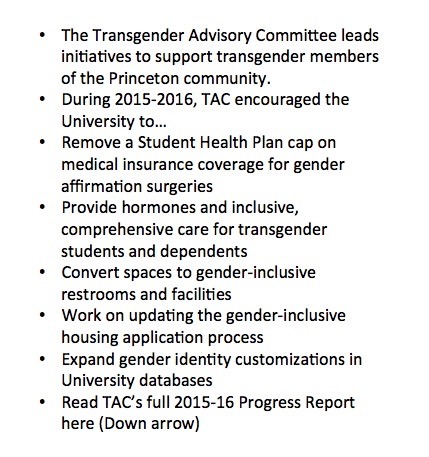
A graphic designer in the Office of Communications helped determine how the slides would look and made two extra slides for the story’s beginning and end.

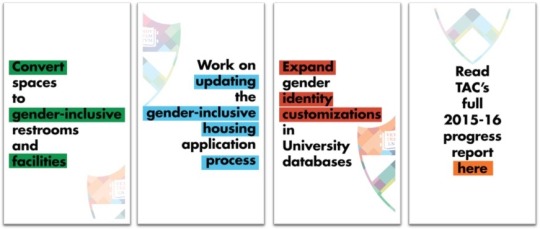
While we shared very basic information in the story, the final slide invited interested viewers to “read TAC’s full 2015-16 progress report” by swiping up on their screens to visit the web page that hosts the full report.
youtube
More than 12,000 people viewed the story in the 24 hours it was live. We don’t know exactly what percentage of those viewers were students, but as 59% of online adults between 18-29 use Instagram, we infer from the overlap with our target audience (18-22) that many of them were.
We plan to use Instagram Stories to illustrate more important University news in the future.
- Ryan Maguire (@ryjmag), Social Media Strategist
#Princeton#Princeton University#PrincetonSM#Instagram#Instagram stories#Snapchat#Social Media#HESM#Higher Education
1 note
·
View note
Text
When Community and Campus Come Together, Students Feel the Love
Finals week is one of the most stressful periods for students during college. Their focus shifts to studying, caffeination and trying to get enough sleep - all in that order. Sometimes it’s easy for students to lose sight of the bigger picture and how many people are there to support them. For Fall 2016 Finals Week, Princeton’s social media team wanted to leverage familiar faces and places around campus and the Town of Princeton in a video, wishing students good luck and to remind them of their wide-reaching support system. Our plan was to post the video on social media, but the project grew to be bigger than that and found its way onto the homepage of the University’s website.
Here are some of the secrets to our success:
Create buy-in through brainstorming. While this was a social media project, we sought out ideas and thoughts from colleagues outside of our immediate team. Because of their contributions, they were interested (and excited) to see the final video on the homepage.
Don’t over-plan. After we developed a list of places and people, we set out to interview whoever was willing to speak on camera - no Outlook calendar invites! We wanted the messages to be authentic and not over-rehearsed.
Think big. We were able to coordinate and record a message from the Mayor of Princeton thanks to an idea that surfaced during our brainstorm session.
Good audio makes for great video. While we filmed with an iPhone, we used an external microphone to record the interviews. This is one piece of equipment we highly recommend investing in for video and livestreaming. For additional branding (and fun), we used a microphone flag with our Snapchat Snapcode.
Corporate can be considered community. While we wanted to highlight local businesses, we didn’t want to exclude the corporate staples in our community that students frequent. Sometimes this may take extra permissioning, but it’s worth it. For instance, Wawa employees, who may see Princeton students as often as their professors do, were excited to be featured but needed to notify their corporate offices. After a quick phone call, Wawa headquarters enthusiastically agreed to be a part of the video.
vimeo
The overall video received nearly 40,000 views across our website and social. In fact, it garnered even more well wishes for students. Also among the comments we received, people shared businesses we need to include for *next time* - which we expect to do considering the outpouring of positive results and support of the campaign!
- Jessica Leontarakis (@jessicafill)
0 notes